
Never worry about visibility
Only need info on a specific topic? Jump down to what you're looking for:
01. Fit
-Gender
-Frame Size & Fitting Guide
-Other Fit Features
02. Lenses
-Type
-Lens Tint & VLT
-Interchangeable Lenses
-Lens Technology & Ventilation
03. Goggle Care
04. How to Avoid Fogging
FIT![]()
Goggles come in a variety of sizes and shapes to suit all kinds of faces and personal preference. While picking a pair of goggles often comes down to style, a comfortable goggle will help ensure that you have a good day of riding. Check out a few of our tips to pick out a Goggle that will work for you.
GENDER![]()
MEN'S
Goggles typically come in an Adult or Junior size, they aren’t really gender specific. As we mentioned above Adult goggle frames come in a variety of sizes, you can use this guide to help you dial down what fit you prefer.
WOMEN'S
Most manufacturer’s don’t make women specific goggles, if they do, they’re typically just in the smaller spectrum of their frame size range and will sometimes feature more feminine colour ways.
KIDS
Junior goggles are usually designed for small faces and focus primarily on being durable. The lenses are usually permanent (can’t be interchanged) and quite basic to keep them inexpensive.
FRAME SIZE![]()
Goggle fit is pretty subjective and your personal preference and overall style will come into play as most people can fit into multiple goggle sizes. As a general rule, think of goggle frame sizes in correlation to the size of your head. If you wear a small helmet, a smaller goggle frame will most likely suit you best, not to mention they will fit together better but we’ll get into the details of helmet compatibility further down. Likewise, if you wear a large or x-large helmet, you’ll likely find a large goggle frame more comfortable.
SMALL
Typically reserved for youths and adults with smaller faces. Women tend to prefer a smaller frame size.
MEDIUM
A medium sized goggle will fit most adults.
LARGE/OVERSIZED
Providing more lens to frame ratio, oversized goggles are becoming increasingly popular. Manufacturers are producing more goggles with larger frames to allow for more peripheral vision. However, larger goggles won’t sit properly on all faces and can sometimes be hard to fit with your helmet. In addition to better peripheral vision, larger goggles also provide better vertical vision which can be especially helpful for snowboarders or for maneuvering steep areas.
OTG
OTG or Over The Glass are designed to fit over your prescription glasses, a much less expensive solution than prescription goggles. These frames will have more depth to make room for your glasses and shouldn’t apply any pressure to your frames; they will also have channels to fit the arms of your glasses so you don’t get any uncomfortable pressure on your temples.
FITTING![]()
Your goggles should fit snugly on your face without moving but shouldn’t cause any uncomfortable pressure. While the frames are typically made of fairly soft materials for flexibility, if the goggles look warped while you have them on, consider a different size or model. Here are a few other common issues and how you can remedy them.
Pinching near the temple: First try to loosen the strap and see if that makes the goggle more comfortable. If you’re still feeling pressure, try a wider frame.
Pinching on the Bridge of the Nose: Move the goggle up a bit on your face and tighten the strap if needed. If this doesn’t help, look for a smaller frame or something with a different shape around the bridge of your nose.
Pressure on the outer eye socket: Chances are, the goggles are too narrow for your face. You shouldn’t feel uncomfortable pressure around your eyes.
Nose bridge gap: Try moving the goggles down your face a bit and loosen the strap if you need to. If you’re still feeling a gap you’ll need a goggle with a wider frame or larger bridge
OTHER FIT FEATURES![]()
Comfort is a personal thing, so goggle fit is quite subjective. Beyond the size of the frame, there are other features of a goggle that will factor into how a goggle will fit.
STRAP
The snugness of a goggle can be adjusted by the strap which usually features a clip or buckle. If the buckle digs into the back of your head while you’re wearing a beanie or adversely if you’ve tightened to strap all the way and the goggles still feel loose, you’ll need a different fit. Wider straps tend to stay put better and are easier to adjust. Another thing to note, especially in children’s goggles, make sure that the strap is adjustable; this will give the goggles longer life as they’ll offer room to grow.
FOAM
For your comfort, goggles are lined with foam which should follow the curvature of your face. To prevent snow and wind from flowing through, there shouldn’t be any gaps. You also shouldn’t feel any uncomfortable pressure or pinching. If you notice either of these things occurring, choose a different goggle.
HELMET COMPATIBILITY
Just about every goggle is helmet compatible nowadays but we always recommend ensuring that they work with your chosen helmet or hat. Just like when trying on goggles over your hat, the goggles shouldn’t move around on your face or warp under tension, if they do, try a different model. If you’re having a hard time finding a goggle that will fit with your helmet, look for models that have arms that extend out from the frame which will help the strap wrap around the helmet and alleviate some pressure from your face. For maximum comfort and keeping your face warm, also make sure that the goggles sit snugly beneath your helmet so you don’t have a gap on your forehead.
LENSES![]()
While the goggle frames vary immensely, lenses are often the make or break feature of a goggle. Different lens types, technology, colour and other features will determine how well it performs and in which conditions they’ll be best suited for. We’ll cover all these elements below so you can feel confident that you’re picking the goggle that you need.
TYPE![]()
There are two major lens types to consider when picking out a goggle.
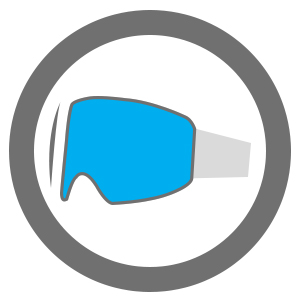 CYLINDRICAL
CYLINDRICAL
Cylindrical or Flat lenses have a horizontal curvature but remain flat vertically. This type of lens still offers good performance but at a lower price point, you’ll still find these lenses in a variety of colours to suit the type of skiing or riding you’ll be doing.![]()
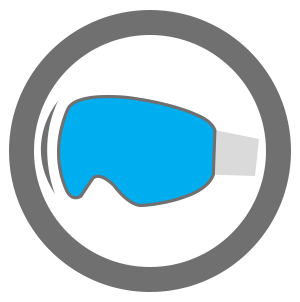 SPHERICAL
SPHERICAL
Spherical lenses curve both vertically and horizontally around your face. They are typically more expensive because they offer better optics in multiple ways.![]()
Peripheral: As we briefly touched on earlier, more lens means better field of vision. Since spherical lenses bubble out, there is more lens surface area giving you better range of vision above and below you, as well as to the sides.
Glare: While many manufacturers will add anti-glare technology to their cylindrical lenses they just simply can’t out perform a spherical lens. Due to its flat surface, a cylindrical lens will always have surface points where the sun hits it and causes glare. The overall curvature of a spherical lens dramatically reduces these points for reduced glare.
Distortion: At certain angles, a cylindrical lens can cause visual distortion because of its flat edges. Spherical lenses allow the light to hit your eyes more naturally as they tend to thin out the further they get from the center of the lens. While manufacturers have developed technology to help reduce this distortion in cylindrical lenses, for the best quality optics, especially in the peripherals, choose a spherical lens.
Fogging: Due to the extra space between your face and the cold, spherical lenses typically allow better air flow and ventilation resulting in less fogging in your goggles.
LENS TINT & VLT![]()
Beyond matching your jacket or gear, there’s a reason goggles come in an endless variety of tints and colours. If you’ve ever been out on a sunny day and felt blinded, you’ll know just how important the right lens can be. From brand to brand there are multiple colours you can choose from and each will filter light differently to offer certain advantages depending on the light and snow conditions. The amount of light a lens allows to pass through is called Visible Light Transmission (VLT). The VLT is measured in a percentage ranging from 0-100.
On days where conditions cause low visibility such as snow or fog, you want more light coming through your goggle lens. A lens with a higher VLT (meaning more light is passing through) is favourable in these situations, something ranging from 60-100%. You’ll commonly see lenses with yellow, rose or blue/green for low light or poor visibility situations. A clear lens is sometimes necessary for night time adventures or truly overcast days. For those blue sky, sunny days your biggest concern will be to minimize the amount of light passing through your lens, something with a VLT range of 5-20%. These lenses will often be tinted black, grey, copper or gold and are often mirrored to reflect light away from your eyes. Of course, there is everything in between; a lens with a VLT in the middle of the range might work best if you experience changing light conditions in a single day.
INTERCHANGEABLE LENSES![]()
Do I need more than one pair of goggles? If you only ski during the day, chances are that you can get away with one darker lens. However, if you like to go out in a variety of conditions, it’s best to have a pair of goggles with lenses that you can swap out depending on visibility. Luckily, most manufacturers have made this simple. Certain goggle models are sold with an alternate lens but you can certainly purchase additional lenses for almost any goggle. This makes swapping lenses fairly quick and painless and means that you don’t have to carry a second pair with you.
In recent years, manufacturers have developed all kinds of technologies to make swapping lenses easier than ever. Brands like ANON offer Magna-Tech on some of their goggle models which uses small magnets to hold your lens in place and making it a snap to swap them out. Other models have small notches that turn out to release the lens, or notches that hold it in place.
TECHNOLOGY & VENTILATION![]()
In addition to shape and tint, goggle manufacturers have developed different technologies to enhance the effectiveness of their goggles and protect your eyes.
UV Protection: In newer models, 100% UV Protection is standard. UV rays can be damaging to your retinas so it’s important to protect your eyes. The UV protection also helps prevent eye fatigue.
Mirrored lenses: These lenses will have a coating on the outside which will reflect more light and keep it out of your eyes. Common in lenses made for bright conditions, the mirrored coating also helps reduce glare.
Double Lens: Again, commonly standard on all newer goggles, a double lens will provide better insulation. Having a better barrier between your face and the cold will help reduce fogging.
Anti-Fog Coating: Applied to the inner side of the lens, an anti-fog coating can greatly reduce a lens’ tendency to fog up. Some coatings last longer than others and always be careful when cleaning your goggles as you might wipe off the coating. Follow the manufacturer’s directions for care.
Photochromic lenses: Photochromic lenses are able to adjust to changing light and UV intensity. While they do take a few minutes to fully adjust to the change in light, these lenses are extremely versatile.
Polarized Lenses: Polarized lenses will reduce the amount of glare you’ll get from the sun and snow. Again, this will help reduce eye fatigue without sacrificing visibility in lower light conditions.
VENTILATION
Most decent goggles have some kind of venting system but as with everything else, some models are designed better than others. In general, the more venting the goggle has, the less fogging you’ll experience. Just be careful when matching your goggles to your helmet so as not to block the vents in your goggles.
GOGGLE CARE![]()
Just like any other eyewear with a lens, goggles are extremely susceptible to scratches, scuffs and cracks. Here are a couple of tips to ensure your goggles stay in good shape and last you a long time.
- When you aren’t using your goggles, store them in a soft pouch or better yet, a protective case. Your goggles are most susceptible to damage while they’re in your gear bag, so keep them protected.
- If you need to wipe down your lenses, only do so on the outside of the lens with a cloth specifically designed for lenses. Use a soft touch to ensure you aren’t wiping off any kind of special coating that is on the lens such as on mirrored lenses.
- Don’t wipe the inside of the lens, that’s where the anti-fog coating is and you risk removing it if you wipe the inside of the lens.
- If you get snow or water in your goggles, shake them out and dab them dry with your goggle cloth, don’t wipe.
- Any time you set your goggles down, set them lens facing up with the face foam on whatever surface you have them on to avoid any scratching.
- Always let your goggles air dry after a day of use but do so out of direct sunlight.
HOW TO AVOID FOGGING![]()
If you’re finding that you’re experiencing a lot of fogging despite having a pair of quality goggles, here are a few tricks that will help you keep them fog free.
- Make sure the vents on your goggles aren’t blocked by your helmet, hat or even snow.
- Shake any snow off your goggles; don’t wipe them, especially if you’re wearing gloves as they can be quite abrasive.
- Airflow helps keep fog out of your goggles so keep moving!
- Put your goggles on before you step out of the lodge, once you step outside, do not put them on your forehead, this will break the seal you’ve created around your face and your goggles will fog.
- If you do get stuck with foggy goggles, you can try to shake them up and down to create airflow but your best bet is to go indoors and dry them out.
• • •
Still have some questions? We've got an extremely knowledgeable and friendly team at Corbetts. Visit us at our retail location or give us a call and we'll help you find the perfect skis to fit your needs.

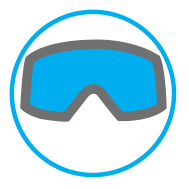
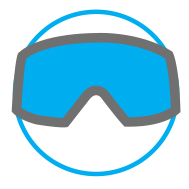
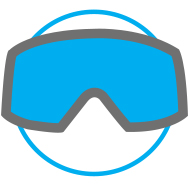 LARGE
LARGE

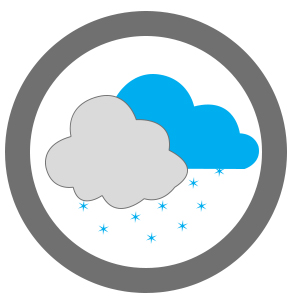
 VLT RANGE:
VLT RANGE: